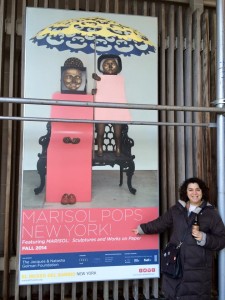
Picture taken at El Barrio Museum in Manhattan (not taken during the LANE meeting but after Christmas. I just thought it looks good with the post)
As the UConn representative to LANE, twice during the academic year, I attend the LANE meetings, where we meet to discuss issues, concerns and share information regarding the acquisition of Latin American, Caribbean and Spanish (Spain) materials for our libraries. We meet each autumn for a whole day meeting, usually in NYC, and at the SALALM Annual meeting when we meet for a smaller meeting.
This last fall, we met at the Bobst Library at New York University. We have a very busy schedule and several guest speakers. The highlight of the meeting was the discussion on ebooks and streaming options for Spanish materials and a demo of new streaming product, Digitalia Film Library.
At this point, options are still limited and business models are still in flux in the Spanish language world (and the same can be said about other foreign languages options for ebooks and streaming films). After our discussion, we realized that although it is a good sign that there are several players entering the Spanish language ebooks market (e.g. Digitalia in Spain, Casalini in Italy(1), and Ventara in Argentina) and one new player in the streaming film market (Digitalia), the whole marketplace is still in its early infancy and there are issues that need to be improved. For example, for ebooks, we are still seeing DRM ebooks; clunky interfaces, and streaming is still an emerging business. Although there is a good amount of Spanish (Spain) publishers represented in ebooks format, Latin American and Caribbean publishers are less represented and therefore the ebooks inventory is very limited—especially for academic-level books. The only vendors selling academic books from Latin American and the Caribbean to libraries are Ventara from Argentina, and Digitalia from Spain, who had made contracts with several academic presses in Latin America and the Caribbean (Chile, Colombia, Peru, Puerto Rico). Mexico does have an ebooks market but they are focusing more in popular titles than in academic ones. So far, Mexico doesn’t have a vendor(s) approaching US academic libraries to sell ebooks yet but it is a matter of times to see such a player enter the marketplace.
In the streaming film area, Digitalia is the only Spanish company offering streaming for libraries. The selection of films in this new product is decent and it’s still growing. One issue that we discussed was the fact that the films in this product do not have subtitles, which is an issue for most of us since students learning Spanish don’t necessarily have the skills to follow the dialogue of movies without subtitles.
Even though things are not perfect yet, it was noted by several librarians in the group that these vendors welcome feedback from LANE and SALALM librarians, and are open to explore new business models, and improve their products to appeal to the US academic libraries’ market. One of the outcomes of our discussion was identifying these issues to be able to contact vendors and share our concerns with them to see if they will address them in the near future. We believe that if many of us share the same concerns with them, the possibility for these vendors to improve their products to make them more appealing to us will increase.
There were two guest’s presentations during the meeting. One by the librarians at the United Nations’ Dag Hammarskjold Library, in New York, who talked about the many free resources online available at their website (from statistics to reports from each of the many departments that comprised the United Nations), and a second presentation by the Library director and the bibliographer of the Museum of Modern Art Library, who talked about their amazing Latin American art collection available to researchers at both their NYC locations (Manhattan and Queens), at their website and at the Arcade, “the catalog of the New York Art Resources Consortium (NYARC)”. One of the choices to search is “Latin American collections” which allow researches to search MoMA’s Latin American art collection.
All in all, a great day conference!
Next posting, Guadalajara’s International Book Fair!
Notes:
(1) Casilini’s Torrossa ebooks platform not only offer ebooks in Spanish but also in Italian, French and Portuguese.
